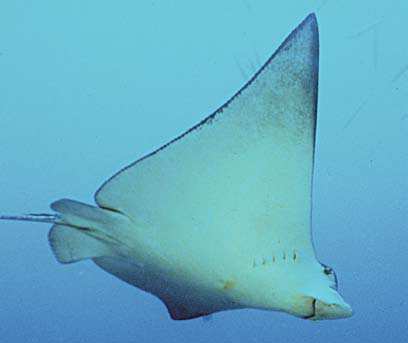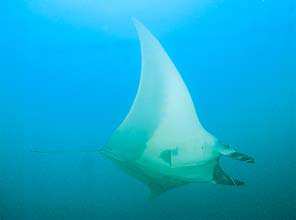MYLIOBATIDAE
Eagle Rays
By Seishi Kimura
 Aetobatus narinari |
 Manta birostris |
|
Medium to large sized batoid rays (ca. 0.6-9 m in total length, ca. 0.6-7 m in disc width). Head with rostal or cephalic fin(s); eyes and spiracles present laterally on head. Five pairs of gill openings located on ventral side of disc. Trunk fused with broad, wing-like pectoral fins, forming a large flattened rhomboidal disc. Body naked or with small denticles covering the dorsal surface. Tail slender, long, whip-like, without caudal fin. A single, small dorsal fin on tail base; one or more poisonous spines (stings) in most species. Color: dorsal surface variable, green, gray, blue, brown, purple, or blackish in ground color; ventral surface generally whitish; pale or dark spots, stripes, and/or ocelli in some species. Similar families occurring in the area. Myliobatidae is distinguished from other batoid families in having rostral or cephalic fin(s); eyes and spiracles laterally on head, a single dorsal fin, and a whip-like tail without caudal fin. Remarks. Three subfamilies, Myliobatinae, Rhinopterinae, and Mobulinae. Usually Occurring in tropical to temperate marine, coastal and offshore areas in Atlantic, Indian, and Pacific Oceans. Viviparous. Usually feed on bivalves, gastropods, crustaceans, and benthic fishes in Myliobatinae and Rhinopterinae, planktonic crustaceans and small fishes in Mobulinae. |

|
|